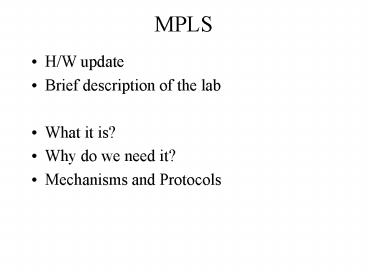MPLS - PowerPoint PPT Presentation
Title: MPLS
1
MPLS
- H/W update
- Brief description of the lab
- What it is?
- Why do we need it?
- Mechanisms and Protocols
2
Multi-Protocol Label Switching(MPLS)
- A mechanism for building tunnels
- Label Switched Path (LSP)
- Forwarding based on labels
- 20 bits for label
- Packet contains MPLS header
- Label
- 3 EXP (experimental) bits
- 8 bits for TTL
- 1 bit for bottom of stack
- EXAMPLE
- LSPs are unidirectional
3
Label Operations
- PUSH
- Add a label on the packet
- At the entry point of the tunnel
- Packet may already have a label
- Label stack
- POP
- Remove a label from the packet
- At the exit point of the tunnel
- SWAP
- Exchange the label on the packet with another one
- During forwarding inside the tunnel
4
LSP
- Has an ingress
- Entrance
- Egress
- Exit
- It goes over some transit nodes
- What traffic does it carry
- Forwarding Equivalence class (FEC)
- Anything that matches some rules that use the IP
header information - We not have the EDGE where information is put
into the LSP - Edge classifies packet into a FEC and there is no
need to do it again inside the network
5
MPLS forwarding
- Routers than can do MPLS forwarding are called
Label Switch Routers (LSRs) - Both a router and an LSR
- Before we had the RIB and FIB
- Now we (also) have the LIB and the LFIB
- Lookup incoming label in LFIB
- Determine where the packet goes and
- What label it should carry
- SWAP labels and send the packet
6
Label Stack
- Can have tunnel hierachies
- Push another label on a labeled path
- I have a label stack
- Forwarding decisions are always based on the
label at the top of the stack - Swap operations apply to the label at the top of
the stack
7
Signaling
- In order to create the LSP somebody has to setup
the labels - They are put in the LFIB Label FIB
- MPLS signaling protocols
- Label Distribution Protocol (LDP)
- RSVP-TE
- Even BGP (for VPNs)
- They distribute labels and establish tunnels
8
Reserved Labels
- 0 IPv4 explicit NULL
- 1 Router Altert
- 2 IPv6 explicit NULL
- 3 - Implicit NULL
- What are these NULLs?
- Determine what the Penultimate hop (PHP) will do
- May pop the label completely
- Or may keep an empty label in the packet
9
PHP
- Penultimate Hop Popping
- The egress scales better
- But does not know that it was an MPLS packet
- Potentially useful information (e.g. EXP bits)
are lost
10
Label Distribution modes
- Ordered vs. Independent
- Will I wait for the downstream nodes to give me
their label? - Unsolicited vs. on-demand
- Will I wait for a neighbor to ask me for a label
or I will send my labels to them anyway? - Label Space
- Per platform
- Per interface
- Labels have link-local scope
- They are unique for the same link only
11
What is the big deal
- Initially people though MPLS forwarding will be
faster than IP forwarding - Not an issue anymore
- Now people like MPLS because it can be used to
setup tunnels - Tunnels for Traffic Engineering
- Tunnels for Recovery from failures
- Tunnels for VPNs
12
How can I use the tunnels
- Use them if I am their ingress
- Can have a static route pointing to a tunnel
next-hop - Share traffic
- Between IGP
- Between IGP/LSPs
- Between LSPs
- Can share with unequal weights
- Advertise them in IGP and use them as links
- forwarding adjacencies
- I already can do things that I could not do with
IGP - Can control quite well where my traffic goes
- EXAMPLE
13
Intro to TE
- An ISP has a number of core routers that attach
to PoPs - ISP usually knows the traffic matrix
- Traffic demands between PoPs
- ISP would like to control exactly how this
traffic moves around in his network - Can setup a full mesh of LSPs and control exactly
what is going on - Of course scalability is a issue
14
RSVP-TE
- Based on Resource Reservation Protocol
- Extended to carry labels (TE)
- It is a signaling protocol
- Sets up network state
- Does not have anything to do with
routing/forwarding - Basic Idea
- I am telling RSVP the path I want and it will
setup an LSP over this path - Specify the whole path
- Loose of strict source route
- RSVP calls it Explicit Route object (ERO)
15
PATH and RESV messages
- Ingress sends a PATH message downstream
- Follows the route we specified until it hits the
egress - ERO or simply IP forwarding towards the
destination - Egress sends a RESV message upstream
- Until it hits the ingress
- Intermediate routers install state
- Labels are allocated
- Downstream ordered mode
16
Soft state
- PATH and RESV messages create state in RSVP
routers - PATH and RESV messages are send periodically to
refresh this state - If state is not refreshed in time it expires and
it is cleared - Simpler
- Do not need to worry about reliable messages etc
- Do not need to check with hellos if my neighbor
is alive - But I have the overhead of state refreshes
17
A big example
- How messages are sent
- How labels are allocated































